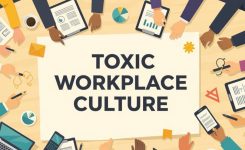blog
Psychosocial Risks in the Workplace: Understand and Mitigate
Maintaining a healthy work environment is crucial for the well-being and productivity of employees. Psychosocial factors can significantly impact mental health if not addressed properly.
The goal of implementing control measures is to minimize workplace factors that may negatively influence mental health and well-being. By understanding and mitigating these risks, organizations can foster a healthier and more productive work environment.
Addressing psychosocial risks is essential for ensuring occupational health and safety. By doing so, employers can reduce the likelihood of mental health issues arising in the workplace.
Key Takeaways
- Understanding psychosocial risks is crucial for maintaining a healthy work environment.
- Control measures can minimize the negative impact of psychosocial factors on mental health.
- Mitigating psychosocial risks fosters a more productive workplace.
- Addressing psychosocial risks is essential for occupational health and safety.
- Employers play a significant role in reducing mental health issues by mitigating psychosocial risks.
Understanding Psychosocial Risks and Their Significance
Understanding psychosocial risks is essential for maintaining a healthy and safe work environment, a fact increasingly acknowledged by organizations worldwide. Psychosocial risks refer to the likelihood that an individual’s psychological or physical well-being will be harmed as a result of workplace hazards. These risks are multifaceted, encompassing factors such as work-related stress, bullying, and job insecurity.
Definition and Scope
Psychosocial risks are defined by the International Organization for Standardization (ISO) in their standard ISO 45003:2021 as aspects of work organization, design, and management that can cause psychological harm. The scope of these risks is broad, affecting not just the individual but also the overall organizational performance. As ISO 45003:2021 emphasizes, understanding the underlying sources of psychosocial harm is crucial before implementing control measures.
The Growing Importance in Modern Work Environments
In today’s fast-paced and often demanding work environments, the significance of psychosocial risks cannot be overstated. As workplaces evolve, factors such as remote work, technological advancements, and changing workforce demographics are altering the landscape of occupational health and safety. According to recent insights, “The modern workplace is witnessing a paradigm shift towards recognizing the importance of mental health and well-being as integral to overall health and safety management.” This shift underscores the need for organizations to proactively manage psychosocial risks.
By understanding and addressing these risks, organizations can foster a healthier, more productive work environment. This not only benefits employees but also contributes to the overall success of the organization.
Common Types of Psychosocial Risks in the Workplace
Understanding the common types of psychosocial risks is crucial for maintaining a healthy and productive work environment. Psychosocial risks can manifest in various forms, each posing unique challenges to employees and organizations.
Work-Related Stress and Excessive Demands
Work-related stress is a significant psychosocial risk, often resulting from excessive demands, tight deadlines, and lack of control over work processes. Chronic stress can lead to burnout, decreased productivity, and increased absenteeism. Employees experiencing high levels of stress may also exhibit reduced job satisfaction and increased turnover intentions.
- High workload and long working hours
- Lack of control over work tasks and processes
- Insufficient resources and support
Workplace Bullying and Harassment
Workplace bullying and harassment are serious psychosocial risks that can have severe consequences on employee well-being and organizational culture. These behaviors can include verbal abuse, intimidation, and exclusion, creating a hostile work environment.
Examples of workplace bullying and harassment include:
- Repeatedly being humiliated or belittled
- Being subjected to unwarranted criticism or blame
- Experiencing exclusion or isolation
Job Insecurity and Organizational Change
Job insecurity and organizational change are significant sources of psychosocial risk. Employees facing job insecurity may experience anxiety, stress, and decreased morale. Organizational changes, such as restructuring or downsizing, can exacerbate these feelings.
Work-Life Imbalance and Boundary Issues
Work-life imbalance occurs when the demands of work interfere with personal and family responsibilities, leading to conflict and stress. The blurring of boundaries between work and personal life, often due to technology, can exacerbate this issue.
To mitigate work-life imbalance, organizations can:
- Implement flexible work arrangements
- Encourage employees to disconnect from work outside work hours
- Provide support for managing work and family responsibilities
The Impact of Psychosocial Hazards on Employee Health
Workplace psychosocial hazards pose a considerable risk to employee health, influencing their mental, physical, and behavioral well-being. The presence of these hazards can lead to a range of health issues that affect employees’ overall quality of life and productivity.
Mental Health Consequences
Psychosocial hazards can have a profound impact on employees’ mental health, leading to issues such as anxiety, depression, and stress-related disorders. Mental health consequences can be severe and long-lasting, affecting not only the individual but also the organization as a whole.
Employees experiencing mental health issues may exhibit decreased job satisfaction, reduced productivity, and increased absenteeism. It is crucial for organizations to recognize the signs of mental health problems and provide support through Employee Assistance Programs (EAPs) or mental health resources.
Physical Health Effects
The physical health effects of psychosocial hazards should not be underestimated. Chronic stress and anxiety can lead to cardiovascular diseases, gastrointestinal problems, and other physical health issues. Physical health effects can result in increased healthcare costs and lost productivity for the organization.
| Health Risk | Potential Outcome |
|---|---|
| Chronic Stress | Cardiovascular Disease |
| Anxiety | Gastrointestinal Issues |
Behavioral Changes and Coping Mechanisms
Employees may exhibit behavioral changes in response to psychosocial hazards, such as increased substance abuse or withdrawal from social interactions. Understanding these changes is crucial for developing effective coping mechanisms and support systems.
Organizations can promote healthy coping mechanisms by providing stress management training and encouraging a healthy work-life balance. By addressing the root causes of psychosocial hazards, organizations can mitigate their negative impact on employee health.
By prioritizing employee health and well-being, organizations can create a positive work environment that fosters productivity, job satisfaction, and overall well-being.
Organizational Consequences of Unaddressed Risks
The organizational consequences of unaddressed psychosocial risks are multifaceted, influencing productivity, employee health, and financial stability. When psychosocial risks are not managed effectively, they can have far-reaching impacts on an organization.
Productivity and Performance Decline
Unaddressed psychosocial risks can lead to a decline in productivity and performance. Employees experiencing stress, bullying, or harassment are likely to be less engaged and less productive. This decline can affect the overall efficiency and effectiveness of the organization.
Increased Absenteeism and Turnover
Psychosocial risks can result in increased absenteeism as employees may need to take time off to manage their mental or physical health. Furthermore, chronic exposure to such risks can lead to turnover, as employees seek healthier work environments. The cost of recruiting and training new employees can be substantial.
Financial and Reputational Costs to Businesses
The financial costs associated with unaddressed psychosocial risks include not only the costs of absenteeism and turnover but also potential legal costs and compensation claims. Additionally, organizations may suffer reputational damage, impacting their ability to attract top talent and maintain customer trust.
| Consequence | Impact |
|---|---|
| Productivity Decline | Reduced Efficiency |
| Increased Absenteeism | Higher Recruitment Costs |
| Reputational Costs | Loss of Customer Trust |
As noted by a workplace safety expert, “Ignoring psychosocial risks can have severe long-term consequences for organizations, making it crucial to address these issues proactively.” 
Legal and Regulatory Framework in the United States
Navigating the legal requirements for managing psychosocial risks is essential for U.S. employers to ensure a safe work environment. The legal framework governing workplace psychosocial risks is multifaceted, involving federal laws, regulations, and state-specific requirements.
OSHA Guidelines and Requirements
The Occupational Safety and Health Administration (OSHA) plays a crucial role in setting standards for workplace safety, including psychosocial risks. OSHA guidelines emphasize the importance of a safe work environment, which encompasses not only physical safety but also mental well-being. Employers are required to maintain a workplace free from recognized hazards, including those that could lead to mental health issues or stress.
ADA Considerations for Mental Health
The Americans with Disabilities Act (ADA) is critical in protecting employees with mental health conditions. Employers must provide reasonable accommodations to employees with disabilities, including mental health disabilities, unless doing so would cause undue hardship. This includes adjusting work schedules, providing leave, or modifying job duties.
State-Specific Regulations and Compliance
In addition to federal regulations, various states have enacted their own laws and regulations concerning workplace psychosocial risks. For instance, some states have specific laws regarding workplace violence, bullying, or stress. Employers must be aware of and comply with these state-specific regulations to avoid legal repercussions and ensure a healthy work environment.
Key aspects of compliance include:
- Regularly reviewing and updating workplace policies to align with current laws and regulations.
- Providing training to employees and supervisors on recognizing and managing psychosocial risks.
- Maintaining accurate records of workplace incidents and near misses related to psychosocial hazards.
By understanding and adhering to the legal and regulatory framework, employers can mitigate psychosocial risks, promote a healthy work environment, and avoid potential legal issues.
Assessing Psychosocial Risks in Your Organization
Psychosocial risk assessment is a vital process that organizations cannot afford to overlook. It involves a systematic evaluation of the workplace to identify potential psychosocial hazards that could impact employee well-being and organizational performance. By understanding these risks, organizations can take proactive steps to mitigate them.
Risk Assessment Tools and Methodologies
Various tools and methodologies are available to assess psychosocial risks. These include standardized questionnaires, workplace audits, and employee interviews. Effective risk assessment requires a combination of these methods to ensure a comprehensive understanding of the workplace environment.

Employee Surveys and Feedback Mechanisms
Employee surveys are a crucial component of psychosocial risk assessment. Tools like the Guarding Minds at Work employee survey help identify employee concerns related to psychosocial hazards. Regular feedback mechanisms ensure that employees feel heard and that their concerns are addressed promptly.
Identifying High-Risk Departments or Roles
Certain departments or roles within an organization may be more susceptible to psychosocial risks. Identifying these high-risk areas is essential for targeted interventions. By analyzing data from risk assessments and employee surveys, organizations can pinpoint where to focus their efforts.
Data Analysis and Trend Identification
Once data is collected, it’s crucial to analyze it to identify trends and patterns. This involves looking at the frequency and severity of psychosocial risks across different departments or roles. Trend identification helps organizations understand the root causes of psychosocial risks and develop effective strategies to mitigate them.
By following these steps, organizations can create a safer, healthier work environment that supports the well-being of all employees.
Comprehensive Prevention Strategies
To effectively manage psychosocial risks, organizations must adopt a multifaceted prevention strategy. This approach involves several key elements that work together to create a healthier and more productive work environment.
Creating a Positive Workplace Culture
A positive workplace culture is foundational to preventing psychosocial risks. It involves fostering an environment of respect, empathy, and support. According to a study, “a culture of openness and support can significantly reduce the incidence of psychosocial hazards”
“A healthy workplace culture is not just a nicety, it’s a necessity for the well-being of employees and the success of the organization.”
Organizations can achieve this by promoting positive relationships among employees and between employees and management.
Leadership Training and Awareness Programs
Leadership training is crucial for recognizing and addressing psychosocial risks. Training programs should equip leaders with the skills to identify early signs of psychosocial distress and respond appropriately. Effective leadership training can lead to a more supportive and aware management team.
Job Design and Workload Management
Proper job design and workload management are critical in preventing work-related stress. This involves ensuring that job demands are reasonable and that employees have the necessary resources to perform their tasks. A balanced workload can significantly reduce the risk of burnout and other psychosocial hazards.
| Job Design Element | Impact on Psychosocial Risks |
|---|---|
| Clear Job Expectations | Reduces uncertainty and stress |
| Autonomy and Control | Enhances job satisfaction and reduces frustration |
| Workload Management | Prevents overwork and burnout |
Communication and Transparency Practices
Open and transparent communication is vital for preventing psychosocial risks. Regular updates about organizational changes and clear communication channels can help reduce uncertainty and anxiety among employees. Transparent communication fosters trust and cooperation within the organization.
By implementing these comprehensive prevention strategies, organizations can significantly reduce psychosocial risks and create a healthier work environment.
Effective Intervention and Mitigation Approaches
Effective intervention and mitigation are key to creating a psychologically healthy work environment. Organizations that proactively address psychosocial risks can significantly improve employee well-being and productivity.
Employee Assistance Programs and Resources
Employee Assistance Programs (EAPs) are a crucial component of an organization’s strategy to mitigate psychosocial risks. These programs provide employees with access to counseling services, mental health resources, and other support mechanisms.
EAPs can include:
- Counseling services for employees and their families
- Mental health resources and referrals
- Work-life balance support
- Substance abuse treatment programs
Stress Management and Resilience Training
Stress management and resilience training are essential for helping employees cope with work-related stress and other psychosocial hazards. These programs teach employees techniques to manage stress effectively and build resilience.
“Resilience is not about being unaffected by challenges, but about being able to bounce back from them.” –
Conflict Resolution and Mediation Procedures
Conflict resolution and mediation procedures are vital for addressing workplace conflicts and bullying. These processes help to resolve issues promptly and fairly, reducing the negative impact on employees.
| Procedure | Description | Benefits |
|---|---|---|
| Mediation | A neutral third party facilitates a resolution between conflicting parties. | Promotes mutual understanding and respect |
| Conflict Resolution Training | Employees are trained in effective conflict resolution techniques. | Enhances communication and reduces future conflicts |
Return-to-Work and Accommodation Programs
Return-to-work and accommodation programs support employees who have been absent due to mental health issues or other psychosocial hazards. These programs facilitate a smooth transition back to work, ensuring that employees receive the necessary support and accommodations.
Success Stories and Case Studies
Several organizations have successfully implemented intervention and mitigation strategies, resulting in improved employee well-being and productivity. For example, a tech company introduced a comprehensive EAP, which led to a significant reduction in employee stress and absenteeism.
By adopting effective intervention and mitigation approaches, organizations can create a healthier and more productive work environment. It is essential to tailor these strategies to the specific needs of the organization and its employees.
Conclusion: Creating Psychologically Healthy Workplaces
Creating a psychologically healthy workplace is crucial for the well-being and productivity of employees. By understanding and mitigating psychosocial risks, organizations can foster a positive work environment that supports mental health and overall workplace well-being.
A comprehensive approach is necessary to address the complex issues surrounding psychosocial risks. This involves implementing strategies such as leadership training, employee assistance programs, and stress management initiatives to promote a culture of care and support.
By prioritizing psychologically healthy workplaces, businesses can reap numerous benefits, including improved employee engagement, reduced absenteeism, and enhanced overall performance. As organizations strive to create a healthier and more supportive work environment, they must remain committed to ongoing assessment and improvement.
Fostering a culture that values mental health and workplace well-being is essential for long-term success. By doing so, organizations can ensure a positive and productive work environment that benefits both employees and the business as a whole.
FAQ
What are psychosocial risks in the workplace?
Psychosocial risks refer to the likelihood of harm to an employee’s mental and physical health due to workplace conditions, including work-related stress, bullying, harassment, and work-life imbalance.
Why is it essential to manage psychosocial risks according to international standards like ISO 45003:2021?
Managing psychosocial risks according to international standards ensures a systematic approach to identifying and mitigating these risks, promoting a healthier and more productive work environment, and complying with regulatory requirements.
What are the common types of psychosocial risks found in the workplace?
Common psychosocial risks include work-related stress, workplace bullying and harassment, job insecurity, and work-life imbalance, which can negatively impact employee well-being and organizational performance.
How do psychosocial hazards affect employee health?
Psychosocial hazards can lead to mental health consequences, physical health effects, and behavioral changes, including anxiety, depression, cardiovascular disease, and substance abuse, ultimately affecting employee well-being.
What are the organizational consequences of unaddressed psychosocial risks?
Unaddressed psychosocial risks can result in decreased productivity and performance, increased absenteeism and turnover, and significant financial and reputational costs to businesses, ultimately impacting their bottom line.
What is the legal and regulatory framework in the United States concerning psychosocial risks?
The legal framework includes OSHA guidelines, ADA considerations for mental health, and state-specific regulations, requiring employers to ensure a safe and healthy work environment and comply with relevant regulations.
How can organizations assess psychosocial risks?
Organizations can assess psychosocial risks using risk assessment tools and methodologies, employee surveys and feedback mechanisms, identifying high-risk departments or roles, and data analysis to understand and address these risks effectively.
What are effective prevention strategies for psychosocial risks?
Effective prevention strategies include creating a positive workplace culture, leadership training and awareness programs, job design and workload management, and effective communication and transparency practices to mitigate psychosocial hazards.
What are some effective intervention and mitigation approaches for psychosocial risks?
Effective approaches include employee assistance programs, stress management and resilience training, conflict resolution and mediation procedures, return-to-work and accommodation programs, and sharing success stories and case studies to illustrate their effectiveness.
How can organizations create psychologically healthy workplaces?
Organizations can create psychologically healthy workplaces by understanding and mitigating psychosocial risks through a comprehensive approach, including prevention strategies, intervention and mitigation approaches, and ongoing monitoring and evaluation.
For more information about investigations regarding workplace issues Click Here
Tags: Employee Wellbeing, Mental Health at Work, Occupational Hazards, Psychosocial Health, Stress Management Strategies, Workplace Environment, Workplace Stress








